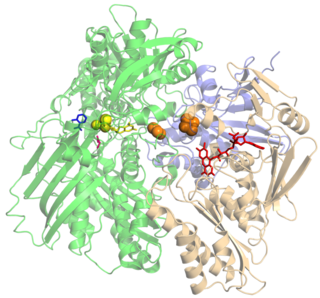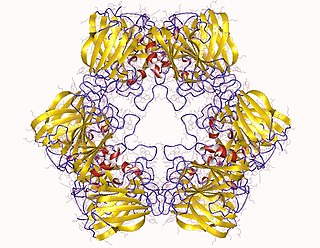
Uric acid is a heterocyclic compound of carbon, nitrogen, oxygen, and hydrogen with the formula C5H4N4O3. It forms ions and salts known as urates and acid urates, such as ammonium acid urate. Uric acid is a product of the metabolic breakdown of purine nucleotides, and it is a normal component of urine. High blood concentrations of uric acid can lead to gout and are associated with other medical conditions, including diabetes and the formation of ammonium acid urate kidney stones.

Xanthine oxidase is a form of xanthine oxidoreductase, a type of enzyme that generates reactive oxygen species. These enzymes catalyze the oxidation of hypoxanthine to xanthine and can further catalyze the oxidation of xanthine to uric acid. These enzymes play an important role in the catabolism of purines in some species, including humans.

Allopurinol is a medication used to decrease high blood uric acid levels. It is specifically used to prevent gout, prevent specific types of kidney stones and for the high uric acid levels that can occur with chemotherapy. It is taken orally or intravenously.

Eicosanoids are signaling molecules made by the enzymatic or non-enzymatic oxidation of arachidonic acid or other polyunsaturated fatty acids (PUFAs) that are, similar to arachidonic acid, around 20 carbon units in length. Eicosanoids are a sub-category of oxylipins, i.e. oxidized fatty acids of diverse carbon units in length, and are distinguished from other oxylipins by their overwhelming importance as cell signaling molecules. Eicosanoids function in diverse physiological systems and pathological processes such as: mounting or inhibiting inflammation, allergy, fever and other immune responses; regulating the abortion of pregnancy and normal childbirth; contributing to the perception of pain; regulating cell growth; controlling blood pressure; and modulating the regional flow of blood to tissues. In performing these roles, eicosanoids most often act as autocrine signaling agents to impact their cells of origin or as paracrine signaling agents to impact cells in the proximity of their cells of origin. Some eicosanoids, such as prostaglandins, may also have endocrine roles as hormones to influence the function of distant cells.

Pyridoxal phosphate (PLP, pyridoxal 5'-phosphate, P5P), the active form of vitamin B6, is a coenzyme in a variety of enzymatic reactions. The International Union of Biochemistry and Molecular Biology has catalogued more than 140 PLP-dependent activities, corresponding to ~4% of all classified activities. The versatility of PLP arises from its ability to covalently bind the substrate, and then to act as an electrophilic catalyst, thereby stabilizing different types of carbanionic reaction intermediates.

Allantoin is a chemical compound with formula C4H6N4O3. It is also called 5-ureidohydantoin or glyoxyldiureide. It is a diureide of glyoxylic acid. Allantoin is a major metabolic intermediate in most organisms including animals, plants and bacteria. It is produced from uric acid, which itself is a degradation product of nucleic acids, by action of urate oxidase (uricase). Allantoin also occurs as a natural mineral compound (IMA symbol Aan).

Rasburicase is a medication that helps to clear uric acid from the blood. It is a recombinant version of urate oxidase, an enzyme that metabolizes uric acid to allantoin. Urate oxidase is known to be present in many mammals but does not naturally occur in humans. Rasburicase is produced by a genetically modified Saccharomyces cerevisiae strain. The complementary DNA (cDNA) coding for rasburicase was cloned from a strain of Aspergillus flavus.
Carboxy-lyases, also known as decarboxylases, are carbon–carbon lyases that add or remove a carboxyl group from organic compounds. These enzymes catalyze the decarboxylation of amino acids, beta-keto acids and alpha-keto acids.

5-Hydroxyisourate is an organic compound that is produced by the oxidation of uric acid. The conversion is a major pathway in the antioxidant properties of urate. The conversion is catalysed by urate oxidase.
The enzyme aconitate decarboxylase (EC 4.1.1.6) (i.e., ACOD1, also termed cis-aconitate decarboxylase, immune-responsive gene 1, immune response gene 1, and IRK1) is a protein enzyme that in humans is encoded by the decarboxylase 1 aconitate decarboxylase 1 gene located at position 22.3 on the long arm (i.e., p-arm) of chromosome 13. ACOD1 catalyzes the following reversible (i.e., runs in both directions, as indicated by ) decarboxylation chemical reaction:

Diphosphomevalonate decarboxylase (EC 4.1.1.33), most commonly referred to in scientific literature as mevalonate diphosphate decarboxylase, is an enzyme that catalyzes the chemical reaction

Allantoicase is an enzyme (EC 3.5.3.4) that in humans is encoded by the ALLC gene. Allantoicase catalyzes the chemical reaction
In enzymology, a hydroxyisourate hydrolase (EC 3.5.2.17) is an enzyme that catalyzes the chemical reaction

Oxoeicosanoid receptor 1 (OXER1) also known as G-protein coupled receptor 170 (GPR170) is a protein that in humans is encoded by the OXER1 gene located on human chromosome 2p21; it is the principal receptor for the 5-Hydroxyicosatetraenoic acid family of carboxy fatty acid metabolites derived from arachidonic acid. The receptor has also been termed hGPCR48, HGPCR48, and R527 but OXER1 is now its preferred designation. OXER1 is a G protein-coupled receptor (GPCR) that is structurally related to the hydroxy-carboxylic acid (HCA) family of G protein-coupled receptors whose three members are HCA1 (GPR81), HCA2, and HCA3 ; OXER1 has 30.3%, 30.7%, and 30.7% amino acid sequence identity with these GPCRs, respectively. It is also related to the recently defined receptor, GPR31, for the hydroxyl-carboxy fatty acid 12-HETE.
Pegloticase is a medication for the treatment of severe, treatment-refractory, chronic gout. It is a third line treatment in those in whom other treatments are not effective or are not tolerated. The drug is administered by infusion intravenously. Since October 2023, Amgen Inc. has been the marketer of pegloticase in the U.S.
In molecular biology 2-oxo-4-hydroxy-4-carboxy-5-ureidoimidazoline decarboxylase EC 4.1.1.n1 is an enzyme involved in purine catabolism. It catalyses the decarboxylation of 2-oxo-4-hydroxy-4-carboxy-5-ureidoimidazoline (OHCU) into S(+)-allantoin. It is the third step of the conversion of uric acid to allantoin. Step one is catalysed by urate oxidase and step two is catalysed by hydroxyisourate hydrolase.
2-hydroxy-4-carboxymuconate semialdehyde hemiacetal dehydrogenase (EC 1.1.1.312, 2-hydroxy-4-carboxymuconate 6-semialdehyde dehydrogenase, 4-carboxy-2-hydroxy-cis,cis-muconate-6-semialdehyde:NADP+ oxidoreductase, alpha-hydroxy-gamma-carboxymuconic epsilon-semialdehyde dehydrogenase, 4-carboxy-2-hydroxymuconate-6-semialdehyde dehydrogenase, LigC, ProD) is an enzyme with systematic name 4-carboxy-2-hydroxymuconate semialdehyde hemiacetal:NADP+ 2-oxidoreductase. This enzyme catalyses the following chemical reaction
FAD-dependent urate hydroxylase is an enzyme with systematic name urate,NADH:oxygen oxidoreductase . A non-homologous isofunctional enzyme (NISE) to HpxO was found, and named HpyO. HpyO was determined to be a typical Michaelian enzyme. These FAD-dependent urate hydroxylases are flavoproteins.
Bacillus fastidiosus is an aerobic, motile, rod-shaped bacterium that has been isolated from soil and poultry litter. The species was first isolated and described by the scientist Den Dooren de Jong in 1929. This organism is a mesophile that contains ellipsoidal spores that do not cause swelling of the sporangia. Bacillus fastidiosus is only able to grow in the presence of uric acid, allantoin, or allantoic acid.

15-Hydroxyeicosatetraenoic acid (also termed 15-HETE, 15(S)-HETE, and 15S-HETE) is an eicosanoid, i.e. a metabolite of arachidonic acid. Various cell types metabolize arachidonic acid to 15(S)-hydroperoxyeicosatetraenoic acid (15(S)-HpETE). This initial hydroperoxide product is extremely short-lived in cells: if not otherwise metabolized, it is rapidly reduced to 15(S)-HETE. Both of these metabolites, depending on the cell type which forms them, can be further metabolized to 15-oxo-eicosatetraenoic acid (15-oxo-ETE), 5(S),15(S)-dihydroxy-eicosatetraenoic acid (5(S),15(S)-diHETE), 5-oxo-15(S)-hydroxyeicosatetraenoic acid (5-oxo-15(S)-HETE), a subset of specialized pro-resolving mediators viz., the lipoxins, a class of pro-inflammatory mediators, the eoxins, and other products that have less well-defined activities and functions. Thus, 15(S)-HETE and 15(S)-HpETE, in addition to having intrinsic biological activities, are key precursors to numerous biologically active derivatives.















